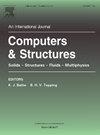A nonlinear dynamics-informed LSTM network for response prediction of strong earthquake-excited high-rise building structures
IF 4.8
2区 工程技术
Q1 COMPUTER SCIENCE, INTERDISCIPLINARY APPLICATIONS
引用次数: 0
Abstract
Long short-term memory (LSTM) networks, which have attracted increasing attention, have emerged as a promising approach for predicting structural dynamic responses, particularly including earthquake-induced time–frequency characteristics. However, due to the multi-modal effects and diverse plasticity development paths in high-rise structures under strong earthquakes, existing LSTM networks fail to explicitly and simultaneously capture such complex dynamic behaviors from a structural dynamics perspective. To address this challenge, this work develops DYNLSTM-Tall, a novel nonlinear dynamics-informed LSTM network, based on two-level mapping relationships derived from the numerical substructure method and a comprehensive time–frequency domain evaluation metric. The architecture of DYNLSTM-Tall and the combined loss function are optimized through ablation experiments across five extended datasets. On this basis, the prediction accuracy and generalization ability of DYNLSTM-Tall is demonstrated by training/validation loss convergence, quantitative evaluation metrics and comparison between predicted vs. actual earthquake response histories of test samples with varying seismic damage states. DYNLSTM-Tall’s superior performance is further validated through comparison with two state-of-the-art LSTM variants across three case high-rise structures, achieving correlation coefficients of 0.95 ∼ 0.98 and accurately identifying up to six lower vibration modes. This research underscores its strong potential as an alternative for seismic risk assessment as well as structural earthquake response prediction.
强震作用下高层建筑结构响应预测的非线性动态LSTM网络
长短期记忆(LSTM)网络作为预测结构动力响应,特别是地震诱发时频特性的一种很有前途的方法,受到了越来越多的关注。然而,由于高层结构在强震作用下的多模态效应和塑性发展路径的多样性,现有的LSTM网络无法从结构动力学的角度明确、同时地捕捉这种复杂的动力行为。为了应对这一挑战,本研究开发了DYNLSTM-Tall,这是一种基于数值子结构方法衍生的两级映射关系和综合时频域评价指标的新型非线性动态LSTM网络。通过五个扩展数据集的烧蚀实验,对DYNLSTM-Tall的结构和组合损失函数进行了优化。在此基础上,通过训练/验证损失收敛性、定量评价指标以及不同震害状态下测试样本的预测与实际地震反应历史对比,验证了DYNLSTM-Tall的预测精度和推广能力。通过与两种最先进的LSTM变体在三种高层结构中的比较,DYNLSTM-Tall的卓越性能得到了进一步验证,相关系数达到0.95 ~ 0.98,并准确识别多达六种较低的振动模式。这项研究强调了它作为地震风险评估和结构地震反应预测的替代方案的强大潜力。
本文章由计算机程序翻译,如有差异,请以英文原文为准。
求助全文
约1分钟内获得全文
求助全文
来源期刊

Computers & Structures
工程技术-工程:土木
CiteScore
8.80
自引率
6.40%
发文量
122
审稿时长
33 days
期刊介绍:
Computers & Structures publishes advances in the development and use of computational methods for the solution of problems in engineering and the sciences. The range of appropriate contributions is wide, and includes papers on establishing appropriate mathematical models and their numerical solution in all areas of mechanics. The journal also includes articles that present a substantial review of a field in the topics of the journal.
 求助内容:
求助内容: 应助结果提醒方式:
应助结果提醒方式:


